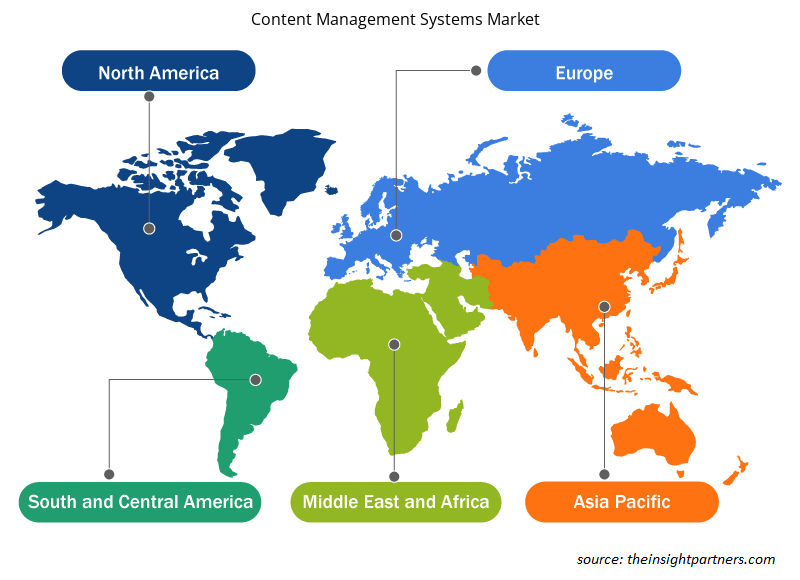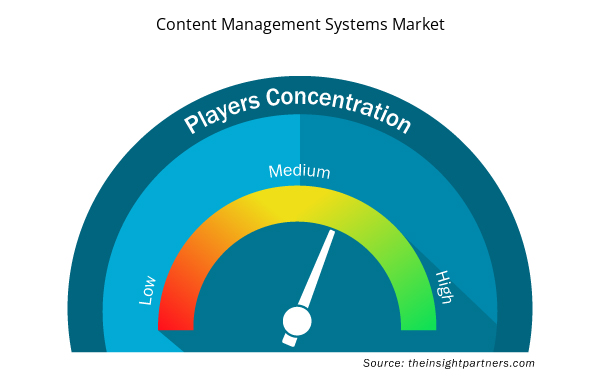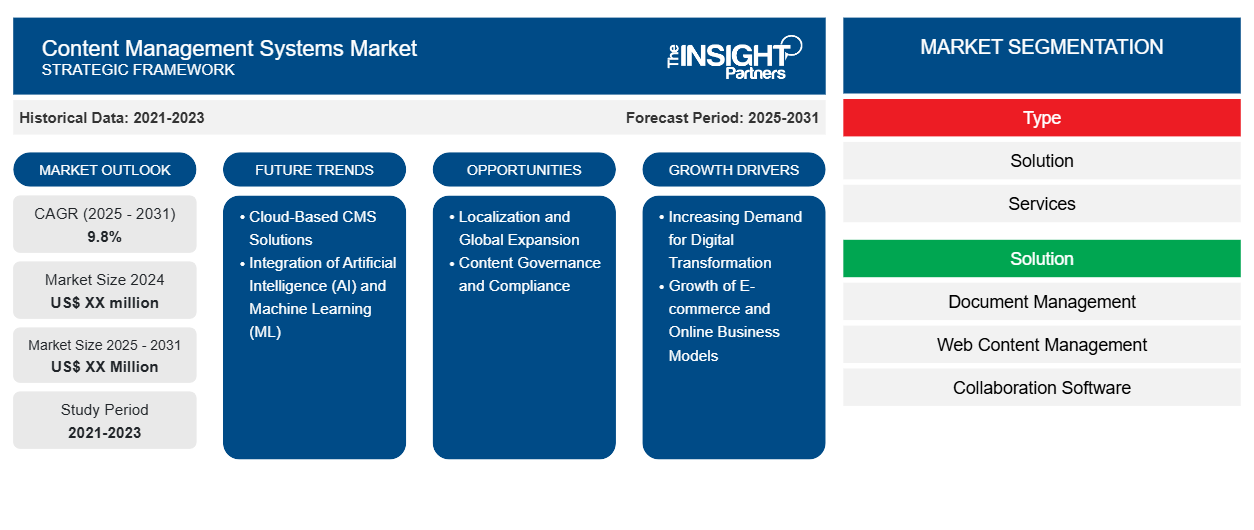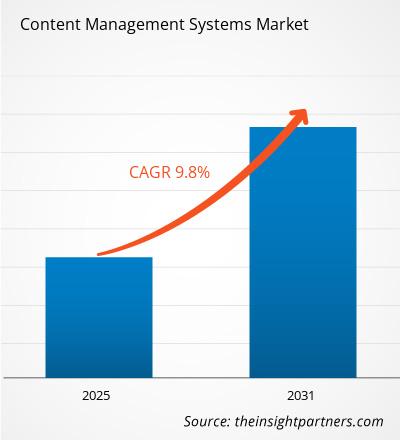Se espera que el mercado de sistemas de gestión de contenido registre una CAGR del 9,8 % entre 2024 y 2031, con un tamaño de mercado que se expandirá de US$ XX millones en 2024 a US$ XX millones en 2031.
El informe está segmentado por tipo (solución, servicios), solución (gestión de documentos, gestión de contenido web, software de colaboración, gestión de derechos digitales, análisis de contenido, otros), implementación (nube, local), uso final (BFSI, gobierno y sector público, atención médica, TI y telecomunicaciones, comercio minorista y comercio electrónico, otros). El análisis global se desglosa aún más a nivel regional y por países principales. El informe ofrece el valor en USD para el análisis y los segmentos anteriores.
Propósito del Informe
El informe Content Management System Market de The Insight Partners tiene como objetivo describir el panorama actual y el crecimiento futuro, los principales factores impulsores, los desafíos y las oportunidades. Esto proporcionará información a diversas partes interesadas del negocio, como:
- Proveedores/fabricantes de tecnología: Para comprender la dinámica cambiante del mercado y conocer las oportunidades potenciales de crecimiento, lo que les permitirá tomar decisiones estratégicas informadas.
- Inversionistas: Realizar un análisis exhaustivo de tendencias sobre la tasa de crecimiento del mercado, las proyecciones financieras del mercado y las oportunidades que existen en toda la cadena de valor.
- Órganos reguladores: Regular las políticas y vigilar las actividades del mercado con el objetivo de minimizar los abusos, preservar la confianza de los inversores y defender la integridad y estabilidad del mercado.
Segmentación del mercado de sistemas de gestión de contenidos
Tipo
- Solución
- Servicios
Solución
- Gestión de documentos
- Gestión de contenido web
- Software de colaboración
- Gestión de derechos digitales
- Análisis de contenido
- Otros
Despliegue
- Nube
- En las instalaciones
Uso final
- BFSI
- Gobierno y sector público
- Cuidado de la salud
- TI y telecomunicaciones
- Comercio minorista y comercio electrónico
- Otros
Personalice este informe según sus necesidades
Obtendrá personalización en cualquier informe, sin cargo, incluidas partes de este informe o análisis a nivel de país, paquete de datos de Excel, así como también grandes ofertas y descuentos para empresas emergentes y universidades.
- Obtenga las principales tendencias clave del mercado de este informe.Esta muestra GRATUITA incluirá análisis de datos, desde tendencias del mercado hasta estimaciones y pronósticos.
Factores impulsores del crecimiento del mercado de sistemas de gestión de contenidos
- Demanda creciente de transformación digital: a medida que las organizaciones de todos los sectores se someten a una transformación digital, ha aumentado la necesidad de soluciones de gestión de contenido eficientes. Las plataformas CMS permiten a las empresas gestionar, crear y distribuir contenido sin problemas a través de varios canales digitales. La creciente tendencia de trasladar las operaciones a Internet y mejorar las experiencias digitales es un factor clave para el mercado de CMS.
- Crecimiento del comercio electrónico y los modelos de negocio online: con la rápida expansión del comercio electrónico, las empresas están invirtiendo fuertemente en plataformas CMS para agilizar la gestión de contenido de productos, mejorar la experiencia del cliente y optimizar las estrategias de marketing digital. Las soluciones CMS permiten una mejor gestión del inventario, la entrega de contenido personalizado y una integración eficiente con otras plataformas de comercio electrónico, lo que impulsa el crecimiento del mercado.
Tendencias futuras del mercado de sistemas de gestión de contenidos
- Soluciones CMS basadas en la nube: la computación en la nube continúa revolucionando el panorama de los CMS. Las plataformas CMS basadas en la nube ofrecen escalabilidad, flexibilidad y rentabilidad en comparación con las soluciones locales tradicionales. La adopción de CMS en la nube está aumentando debido a su capacidad para respaldar la distribución de contenido global, la colaboración fluida y los costos reducidos de mantenimiento de la infraestructura.
- Integración de inteligencia artificial (IA) y aprendizaje automático (ML): la IA y el ML se están integrando cada vez más en las plataformas CMS para mejorar la gestión de contenido. La IA ayuda a automatizar el etiquetado de contenido, mejorar las capacidades de búsqueda, brindar recomendaciones de contenido personalizadas y analizar el comportamiento del usuario para obtener mejores estrategias de contenido. A medida que avanza la tecnología de IA, las soluciones CMS se vuelven más inteligentes e intuitivas.
Oportunidades de mercado para sistemas de gestión de contenidos
- Localización y expansión global: A medida que las empresas buscan expandir su alcance a nivel mundial, la localización de contenido se convierte en un factor crítico. Las soluciones CMS pueden ofrecer traducción automática, herramientas de localización y soporte multilingüe, lo que permite a las empresas adaptar su contenido a diferentes regiones e idiomas, ampliando así su alcance de mercado y mejorando la interacción con los clientes a escala global.
- Cumplimiento y gobernanza de contenido: con regulaciones de protección de datos más estrictas como GDPR y CCPA, las empresas buscan cada vez más soluciones CMS que puedan garantizar el cumplimiento y la gobernanza de contenido. Las plataformas CMS pueden ayudar a automatizar los flujos de trabajo de cumplimiento, proporcionar registros de auditoría y hacer cumplir las políticas de contenido, lo que presenta una oportunidad importante para los proveedores que ofrecen funciones sólidas de gobernanza de contenido.
Perspectivas regionales del mercado de sistemas de gestión de contenido
Los analistas de Insight Partners explicaron en detalle las tendencias y los factores regionales que influyen en el mercado de sistemas de gestión de contenido durante el período de pronóstico. Esta sección también analiza los segmentos y la geografía del mercado de sistemas de gestión de contenido en América del Norte, Europa, Asia Pacífico, Oriente Medio y África, y América del Sur y Central.

- Obtenga datos regionales específicos para el mercado de sistemas de gestión de contenido
Alcance del informe de mercado de sistemas de gestión de contenido
| Atributo del informe | Detalles |
|---|---|
| Tamaño del mercado en 2024 | XX millones de dólares estadounidenses |
| Tamaño del mercado en 2031 | US$ XX millones |
| CAGR global (2024 - 2031) | 9,8% |
| Datos históricos | 2021-2023 |
| Período de pronóstico | 2025-2031 |
| Segmentos cubiertos | Por tipo
|
| Regiones y países cubiertos | América del norte
|
| Líderes del mercado y perfiles de empresas clave |
|
Densidad de actores del mercado de sistemas de gestión de contenido: comprensión de su impacto en la dinámica empresarial
El mercado de sistemas de gestión de contenido está creciendo rápidamente, impulsado por la creciente demanda de los usuarios finales debido a factores como la evolución de las preferencias de los consumidores, los avances tecnológicos y una mayor conciencia de los beneficios del producto. A medida que aumenta la demanda, las empresas amplían sus ofertas, innovan para satisfacer las necesidades de los consumidores y aprovechan las tendencias emergentes, lo que impulsa aún más el crecimiento del mercado.
La densidad de actores del mercado se refiere a la distribución de las empresas o firmas que operan dentro de un mercado o industria en particular. Indica cuántos competidores (actores del mercado) están presentes en un espacio de mercado determinado en relación con su tamaño o valor total de mercado.
Las principales empresas que operan en el mercado de sistemas de gestión de contenidos son:
- Corporación Oracle
- Corporación OpenText
- Cisco Systems Inc
- Corporación IBM
- Corporación EMC
Descargo de responsabilidad : Las empresas enumeradas anteriormente no están clasificadas en ningún orden particular.

- Obtenga una descripción general de los principales actores clave del mercado de sistemas de gestión de contenido
Puntos de venta clave
- Cobertura integral: el informe cubre de manera integral el análisis de productos, servicios, tipos y usuarios finales del mercado del sistema de gestión de contenido, proporcionando un panorama holístico.
- Análisis de expertos: el informe se compila sobre la base de un profundo conocimiento de expertos y analistas de la industria.
- Información actualizada: El informe asegura relevancia comercial debido a su cobertura de información reciente y tendencias de datos.
- Opciones de personalización: este informe se puede personalizar para satisfacer los requisitos específicos del cliente y adaptarse adecuadamente a las estrategias comerciales.
Por lo tanto, el informe de investigación sobre el mercado de sistemas de gestión de contenido puede ayudar a abrir camino para descifrar y comprender el escenario de la industria y las perspectivas de crecimiento. Si bien puede haber algunas preocupaciones válidas, los beneficios generales de este informe tienden a superar las desventajas.
- Análisis histórico (2 años), año base, pronóstico (7 años) con CAGR
- Análisis PEST y FODA
- Tamaño del mercado Valor/volumen: global, regional, nacional
- Industria y panorama competitivo
- Conjunto de datos de Excel


- Employment Screening Services Market
- Authentication and Brand Protection Market
- High Speed Cable Market
- Trade Promotion Management Software Market
- Enteral Nutrition Market
- Neurovascular Devices Market
- Asset Integrity Management Market
- Public Key Infrastructure Market
- Cut Flowers Market
- Medical and Research Grade Collagen Market

Report Coverage
Revenue forecast, Company Analysis, Industry landscape, Growth factors, and Trends

Segment Covered
This text is related
to segments covered.

Regional Scope
North America, Europe, Asia Pacific, Middle East & Africa, South & Central America

Country Scope
This text is related
to country scope.
Preguntas frecuentes
The report can be delivered in PDF/PPT format; we can also share excel dataset based on the request
Headless CMS architecture to play a significant role in the global content management system market in the coming years
The Content Management System Market is estimated to witness a CAGR of 9.8% from 2023 to 2031
Digital transformation initiatives and rising demand for personalized content are the major factors driving the content management system market
Trends and growth analysis reports related to Technology, Media and Telecommunications : READ MORE..
1. Oracle Corporation
2. OpenText Corporation
3. Cisco Systems Inc
4. IBM Corporation
5. EMC Corporation
6. Microsoft Corporation
7. Hyland Software
8. Xerox Corporation
9. T- Systems Ltd
10. Integro Inc
11. Deloitte
The Insight Partners performs research in 4 major stages: Data Collection & Secondary Research, Primary Research, Data Analysis and Data Triangulation & Final Review.
- Data Collection and Secondary Research:
As a market research and consulting firm operating from a decade, we have published and advised several client across the globe. First step for any study will start with an assessment of currently available data and insights from existing reports. Further, historical and current market information is collected from Investor Presentations, Annual Reports, SEC Filings, etc., and other information related to company’s performance and market positioning are gathered from Paid Databases (Factiva, Hoovers, and Reuters) and various other publications available in public domain.
Several associations trade associates, technical forums, institutes, societies and organization are accessed to gain technical as well as market related insights through their publications such as research papers, blogs and press releases related to the studies are referred to get cues about the market. Further, white papers, journals, magazines, and other news articles published in last 3 years are scrutinized and analyzed to understand the current market trends.
- Primary Research:
The primarily interview analysis comprise of data obtained from industry participants interview and answers to survey questions gathered by in-house primary team.
For primary research, interviews are conducted with industry experts/CEOs/Marketing Managers/VPs/Subject Matter Experts from both demand and supply side to get a 360-degree view of the market. The primary team conducts several interviews based on the complexity of the markets to understand the various market trends and dynamics which makes research more credible and precise.
A typical research interview fulfils the following functions:
- Provides first-hand information on the market size, market trends, growth trends, competitive landscape, and outlook
- Validates and strengthens in-house secondary research findings
- Develops the analysis team’s expertise and market understanding
Primary research involves email interactions and telephone interviews for each market, category, segment, and sub-segment across geographies. The participants who typically take part in such a process include, but are not limited to:
- Industry participants: VPs, business development managers, market intelligence managers and national sales managers
- Outside experts: Valuation experts, research analysts and key opinion leaders specializing in the electronics and semiconductor industry.
Below is the breakup of our primary respondents by company, designation, and region:

Once we receive the confirmation from primary research sources or primary respondents, we finalize the base year market estimation and forecast the data as per the macroeconomic and microeconomic factors assessed during data collection.
- Data Analysis:
Once data is validated through both secondary as well as primary respondents, we finalize the market estimations by hypothesis formulation and factor analysis at regional and country level.
- Macro-Economic Factor Analysis:
We analyse macroeconomic indicators such the gross domestic product (GDP), increase in the demand for goods and services across industries, technological advancement, regional economic growth, governmental policies, the influence of COVID-19, PEST analysis, and other aspects. This analysis aids in setting benchmarks for various nations/regions and approximating market splits. Additionally, the general trend of the aforementioned components aid in determining the market's development possibilities.
- Country Level Data:
Various factors that are especially aligned to the country are taken into account to determine the market size for a certain area and country, including the presence of vendors, such as headquarters and offices, the country's GDP, demand patterns, and industry growth. To comprehend the market dynamics for the nation, a number of growth variables, inhibitors, application areas, and current market trends are researched. The aforementioned elements aid in determining the country's overall market's growth potential.
- Company Profile:
The “Table of Contents” is formulated by listing and analyzing more than 25 - 30 companies operating in the market ecosystem across geographies. However, we profile only 10 companies as a standard practice in our syndicate reports. These 10 companies comprise leading, emerging, and regional players. Nonetheless, our analysis is not restricted to the 10 listed companies, we also analyze other companies present in the market to develop a holistic view and understand the prevailing trends. The “Company Profiles” section in the report covers key facts, business description, products & services, financial information, SWOT analysis, and key developments. The financial information presented is extracted from the annual reports and official documents of the publicly listed companies. Upon collecting the information for the sections of respective companies, we verify them via various primary sources and then compile the data in respective company profiles. The company level information helps us in deriving the base number as well as in forecasting the market size.
- Developing Base Number:
Aggregation of sales statistics (2020-2022) and macro-economic factor, and other secondary and primary research insights are utilized to arrive at base number and related market shares for 2022. The data gaps are identified in this step and relevant market data is analyzed, collected from paid primary interviews or databases. On finalizing the base year market size, forecasts are developed on the basis of macro-economic, industry and market growth factors and company level analysis.
- Data Triangulation and Final Review:
The market findings and base year market size calculations are validated from supply as well as demand side. Demand side validations are based on macro-economic factor analysis and benchmarks for respective regions and countries. In case of supply side validations, revenues of major companies are estimated (in case not available) based on industry benchmark, approximate number of employees, product portfolio, and primary interviews revenues are gathered. Further revenue from target product/service segment is assessed to avoid overshooting of market statistics. In case of heavy deviations between supply and demand side values, all thes steps are repeated to achieve synchronization.
We follow an iterative model, wherein we share our research findings with Subject Matter Experts (SME’s) and Key Opinion Leaders (KOLs) until consensus view of the market is not formulated – this model negates any drastic deviation in the opinions of experts. Only validated and universally acceptable research findings are quoted in our reports.
We have important check points that we use to validate our research findings – which we call – data triangulation, where we validate the information, we generate from secondary sources with primary interviews and then we re-validate with our internal data bases and Subject matter experts. This comprehensive model enables us to deliver high quality, reliable data in shortest possible time.


 Obtenga una muestra gratuita de este informe
Obtenga una muestra gratuita de este informe